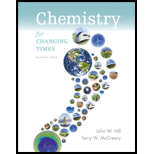
Concept explainers
Toluene (C7H8) and nitric acid (HNO3) are used in the production of trinitrotoluene (TNT, C7H5N3O6), an explosive.
What mass in grams (a) of nitric acid is required to react with 454 g and (b) of TNT can be made from 829 g C7H8?
Want to see the full answer?
Check out a sample textbook solution
Chapter 5 Solutions
Chemistry For Changing Times (14th Edition)
- Can you please draw out the Lewis structure for these two formulasarrow_forwardIn a rotational Raman spectrum of a diatomic molecule it is correct to say that:a) anti-Stokes lines occur at frequencies higher than the excitatory oneb) Stokes lines occur at frequencies higher than the excitatory onec) Rayleigh scattering is not observedd) Rayleigh scattering corresponds to delta J = 0arrow_forwardOf the molecules: H2, N2, HCl, CO2, indicate which ones can give Raman vibration-rotation spectra:a) H2, N2 and HClb) H2, N2, HCl and CO2c) H2 and N2d) all of themarrow_forward
- Can you please help me with drawing the Lewis structure of each molecular formula?I truly appreciate you!arrow_forwardCan you please help me with drawing the Lewis structure of each molecular formula?I truly appreciate you!arrow_forwardCan you please help me with drawing the Lewis structure of each molecular formula?I truly appreciate you!arrow_forward
- Can you please help me with drawing the Lewis structure of each molecular formula?I truly appreciate you!arrow_forwardPlease draw and explainarrow_forwardDescribe each highlighted bond in terms of the overlap of atomic orbitals. (a) Н Н H H [References] HIC H H C H H-C-CC-N: H σ character n character (b) HIC H H H H-C-C-C HIC H Н H O-H σ character n character Submit Answer Try Another Version 3 item attempts remainingarrow_forward
- 11 Naming and drawing alcohols Write the systematic (IUPAC) name for each of the following organic molecules: structure OH HO OH Explanation Check name ☐arrow_forwardwhat is the drawn mechanism for diethyl carbonate and 4 - bromo - N, N -dimethylaniline to create crystal violet?arrow_forwardWhich of the following compounds are constitutional isomers of each other? I and II O II and III O III and IV OI and IV O II and IV CI H CI H CI H H CI H-C-C-CI C-C-C-CI H-C-C-CI H-C-C-CI H CI Ĥ ĆI A A Ĥ ĆI || IVarrow_forward
 Chemistry for Engineering StudentsChemistryISBN:9781337398909Author:Lawrence S. Brown, Tom HolmePublisher:Cengage Learning
Chemistry for Engineering StudentsChemistryISBN:9781337398909Author:Lawrence S. Brown, Tom HolmePublisher:Cengage Learning Chemistry: Principles and PracticeChemistryISBN:9780534420123Author:Daniel L. Reger, Scott R. Goode, David W. Ball, Edward MercerPublisher:Cengage Learning
Chemistry: Principles and PracticeChemistryISBN:9780534420123Author:Daniel L. Reger, Scott R. Goode, David W. Ball, Edward MercerPublisher:Cengage Learning Chemistry & Chemical ReactivityChemistryISBN:9781337399074Author:John C. Kotz, Paul M. Treichel, John Townsend, David TreichelPublisher:Cengage Learning
Chemistry & Chemical ReactivityChemistryISBN:9781337399074Author:John C. Kotz, Paul M. Treichel, John Townsend, David TreichelPublisher:Cengage Learning General, Organic, and Biological ChemistryChemistryISBN:9781285853918Author:H. Stephen StokerPublisher:Cengage Learning
General, Organic, and Biological ChemistryChemistryISBN:9781285853918Author:H. Stephen StokerPublisher:Cengage Learning Chemistry: The Molecular ScienceChemistryISBN:9781285199047Author:John W. Moore, Conrad L. StanitskiPublisher:Cengage Learning
Chemistry: The Molecular ScienceChemistryISBN:9781285199047Author:John W. Moore, Conrad L. StanitskiPublisher:Cengage Learning ChemistryChemistryISBN:9781305957404Author:Steven S. Zumdahl, Susan A. Zumdahl, Donald J. DeCostePublisher:Cengage Learning
ChemistryChemistryISBN:9781305957404Author:Steven S. Zumdahl, Susan A. Zumdahl, Donald J. DeCostePublisher:Cengage Learning





